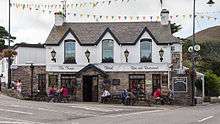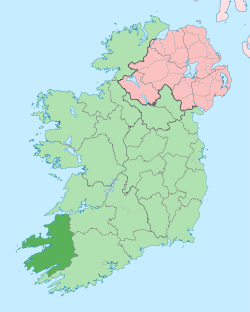Glenbeigh
| Glenbeigh Gleann Beithe
 Rossbeigh Beach Glenbeigh | |
|---|---|
| Parish | |
 Glenbeigh Location in Ireland | |
| Coordinates: 52°03′29″N 9°56′16″W / 52.058056°N 9.937778°WCoordinates: 52°03′29″N 9°56′16″W / 52.058056°N 9.937778°W | |
| Country | Ireland |
| Province | Munster |
| County | County Kerry |
| Elevation | 50 m (160 ft) |
| Population (2011)[1] | |
| • Total | 1,013 |
| Website |
www |
Glenbeigh or Glanbehy (Irish: Gleann Beithe, meaning "valley of the Birch trees") is a location in County Kerry, southwestern Ireland. The area is on the Iveragh peninsula, which is the largest peninsula in southwestern Ireland. The parish and is home to Rossbeigh Beach, Glenbeigh Towers, Coomasahran Lake, Rock Art, the Natterjack Toad and Kerry Bog Pony. Owing to its natural heritage, history and its location on the Ring of Kerry, Glenbeigh is a popular tourist destination.
Glenbeigh is often referred to as "The Jewel in the Ring of Kerry". It is cosily tucked in to the surrounding horseshoe of hills and Seefin Mountains. The Caragh River and the Behy River flow at either side of the village into Castlemaine Harbour.
History
Many Fianna legends centre around Glenbeigh where Diarmuid and Grainne spent some days hiding in a cave in the valley of the Behy, where Diarmuid achieved such exploits against his pursuers. Rossbeigh is known for where Oisin and Niamh took to the sea on their white horse to live in the land of youth - Tir na nOg.
Near the village is the ruin of "Wynne's Folly", a castle mansion built by Lord Headley Wynne in 1867. The terrible tragedies which befell the population of the Wynn Estate in the parish of Glenbeigh, in the 1880s is still talked about in the Glenbeigh area. The barbarity and brutality of Mr Roe, the agent for Lord Wynne, during the evictions were said to be far in excess of the worst actions of his master. Even Gladstones Land Act of 1881 which in effect said that tenants should no longer be removed at will, did little for the residents of the Wynn Estate, as during the years of 1882 and 1883 there were numerous evictions because the tenants were just not able to afford the increased rent, by a massive 50% in most cases, to pay for the construction of the castle. Not very long after this the affairs of Wynn drifted into insolvency and he made his exit from the Glenbeigh scene.While World War I was in progress the Castle and grounds were let to the British Military Command and used as a training centre for reservists. In 1921 Republican forces burned the castle to the ground and it was never rebuilt.
One of Kerry's finest walks follows the Glenbeigh Horseshoe, circuit of hills from Seefin to Drung Hill, with a never ending succession of panoramic close-ups of glacial corries, lakes and magnificent scenery.
Rossbeigh Strand located nearby is a beautiful stretch of sandy beach known for safe swimming and water sports lies under the shadow of Curra Hill. A tower built more than a century ago stood at the north end of the sandhills, which was a guide mark for ships entering Castlemaine Harbour.
Caragh Lake is a beautiful expanse of water 4 miles long set among broom and heather with majestic mountains for background at the eastern end of village is well known to anglers for excellent fishing.
Coomasharn Lake, the largest of the lakes in Glenbeigh, is enclosed on three sides by high rocky mountains protecting it from modern polluters is known for its trout fishing and is one of the lakes in Ireland which has the Sliver Blue Char, an eel water fish.
Glenbeigh is a very popular holiday base for touring the Ring of Kerry. Fine restaurants, pubs, petrol station and fantastic scenery are all to be found in the locality.
Built Heritage
There are six structures included in the Record of Protected.

Structures which are as follows:
- - Glenbeigh Tower Duchas ref: 21306301
- - Church of Ireland Duchas ref: 21306302
- - The Towers Hotel Duchas ref: 21306303
- - St. James Catholic Church Duchas ref: 21306304
- - Glenbeigh Hotel Duchas ref: 21306305
- - Cottage RPS ref: 063-001
The following structures are considered to be of sufficient architectural and heritage value to be considered for inclusion in the Record of Protected Structures:
- - One cottage in a terrace of three houses to the north of Main Street.
- - The Behy Bridge.
The Glenbeigh Towers benefiting from a dominant, elevated position, in an attractive open landscape setting, is an imposing feature in the landscape. Viewed from the N70 National Road this 18th century Tower and its natural setting are particularly powerful and resonate with the history of its time. The rising ground which forms the foreground to the Towers is in an area of undeveloped grassland enhanced by groups of mature trees. In addition to its heritage value, the ruins are closely associated with the character and identity of the village. In order to safeguard the full heritage values of the Towers, it is essential to protect the landscape setting. In addition to the architectural and social value found in individual buildings existing streetscapes present an attractive traditional aspect which is important to the community and in its contribution to tourism. While it is not intended to designate any particular street as a conservation area, it is necessary to ensure that the local character and sense of place are enhanced and a coherent urban structure is created. It is important therefore that new development reflects the traditional elements of the historic streetscape.
Natural Environment
Glenbeigh is set within an attractive and varied landscape ranging from the Rossbeigh beach and mudflats with spectacular views across the bay, to the wooded Seefin Mountain. Although the landscape has significant amenity value it is not designated as a landscape conservation area. The River Behy traverses the western village boundary meeting Rossbeigh Creek and Lake Carragh to the north and to the south, the lakes of Coomaglaslan and Coomasaharn. There are two candidate Special Areas of Conservation in the vicinity of the plan area.
Functions
Glenbeigh functions as a local service centre for its catchment area and as a centre for tourism. The village is situated in a scenic area at an intersection of the Kerry Way walking trail and the Ring of Kerry motorists’ route and as such is a popular tourist destination. The proximity of Rossbeigh beach is an integral part of the village’s tourist attractions. Glenbeigh is the main local service centre for Rossbeigh and there is therefore, a strong functional link between the two settlements.
Facilities
The village offers a range of local retail and social services including a church, community centre and garda station. Retail outlets are minimal suggesting that Killorglin caters for the majority of retail needs. The adjacent blue flag beach and walking routes provide outdoor recreational opportunities for local people and tourists alike. There are a number of small hotels, bed and breakfast accommodation and holiday homes.
Infrastructure
The village is currently served by a waste water treatment plant. The plant is currently operating at capacity and a preliminary report has been prepared for the construction of 2,500pe waste water treatment plant. This current lack of capacity will act as a significant constraint on development within the period of this plan. The proposed waste water system will become operational in the medium term. The village is served by a public water mains supply.
Urban Form
The village is largely linear in nature with extensive areas of undeveloped land to the rear of roadside development. The creation of in- depth development would provide for a more compact and sustainable urban form. The village has a small but strongly defined urban core centred on a staggered junction. Streetscape although broken in parts features along both sides of the N70 from the village post office on the Cahersiveen Road, to the Garda Station on the Tralee Road. Village architecture consists largely of traditional 19th century structures.
The number of vacant/ derelict sites within the village is small, but new development which will break the building line at these locations would undermine the village’s potential to develop a stronger village form and should not be considered. Extending the streetscape to include vacant sites on the perimeter of the existing street would serve to reinforce the character of the village centre while allowing for the expansion of its retail and service core.
Tourism is a significant part of the local economy and the traditional character of the village is an important part of the villages tourist appeal. New development will need to reflect the traditional character of Glenbeigh’s built form in order to maintain and enhance this tourist asset. With the exception of Seefin Mountain land to the west slopes towards the coast. There are therefore, a number of points within the village with a view across the bay to the Dingle Mountains. The location of the church and its orientation overlooking the central junction is an attractive streetscape feature. The prevalence of both individual and groups of trees coupled with mature hedgerows softens and enhances the built form and makes a significant contribution to the character of the area. Such plantings are most marked on the Cahersiveen Road. Houses outside the streetscape area are largely set back and well landscaped giving the approach to the village a rural aspect. Outside the designated streetscape area new development should be similar in nature in order to retain attractive approaches to the village. Extensive development of one off housing has occurred on local roads in the vicinity of the village creating a haphazard development pattern which is unsustainable, erodes the rural environment and undermines the development of a compact village form.
Attractions
- Rossbeigh Beach
- Glenbeigh Towers
- Coomasahran Lake
- Rock Art
- Natterjack Toad
- Kerry Bog Pony
- Caragh Lake
- Caragh River
See also
References
External links
| Wikimedia Commons has media related to Glenbeigh. |
For further information on Glenbeigh: http://www.glenbeigh.ie https://www.facebook.com/glenbeigh.ie
